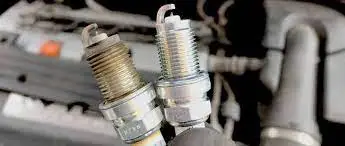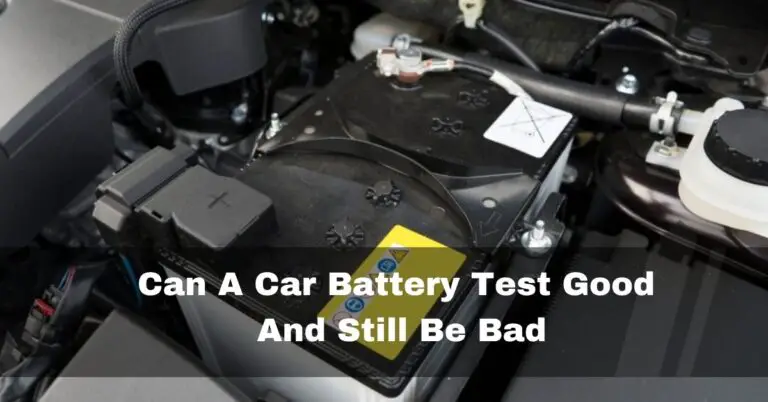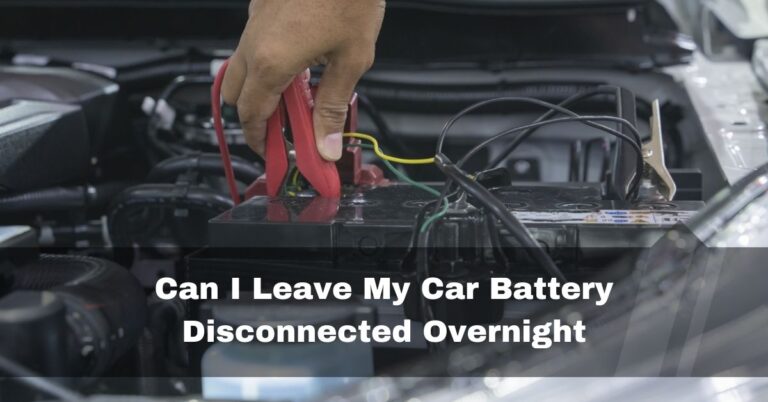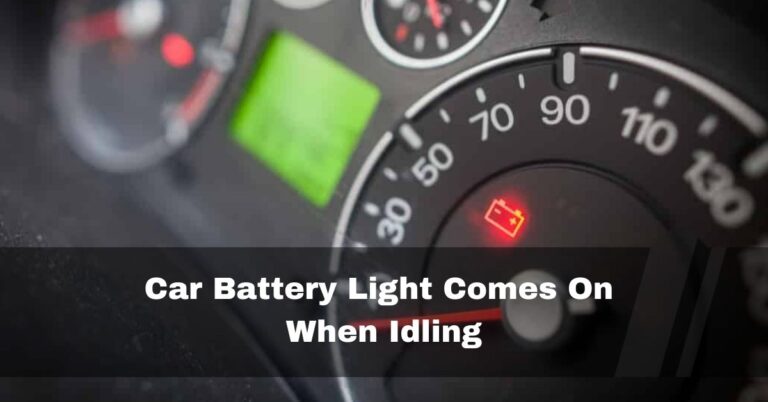Car Dies When Removing Positive Battery Cable – Fix In 2024
Safety must always come first when maintaining a vehicle, and recommended procedures should always be followed. The unwavering recommendation to avoid removing the positive (+) battery cable without careful thinking is one of these procedures.
If the engine shuts off when the battery is disconnected then it is very likely your alternator has failed. Removing the positive battery cable while the car is running can disrupt the electrical system, causing the car to stall due to power loss.
In this comprehensive guide, we’ll explore the reasons behind a car’s stall after removing the positive battery cable and outline effective steps to tackle any issues that may arise.
Table of Contents
Understanding Battery Arcing: The Core Issue:
Battery arcing can occur if the positive battery cable is disconnected before the negative cable, leading to deadly sparks. This is caused by a buildup of static charge on the cable. When the electric field is strong enough, electrons accelerate across the gap, creating a plasma and audible spark. Always begin with the negative cable when disconnecting the battery to avoid this issue.
Dangers Of Battery Arcing:
Battery arcing can trigger extensive damage to critical components of your vehicle, including:
- Battery: Arcing can lead to corroded terminals, decreased charge storage capacity, and a shorter lifespan.
- Alternator: Common problems include overheating and failure of this crucial component, which recharges the battery.
- Fuses: Arcing can result in fuses blowing, interfering with the operation of numerous electrical parts.
- Wiring and cables: The heat produced during arcing can cause wires and cables to melt or burn.
- Distributor Cap: The distributor cap may burst due to heat accumulation from arcing.
- Spark Plugs: The ceramic insulators in spark plugs tend to melt under the intense heat of arcing.
- Starter motor: Arcing-related damage to this component may necessitate repair or replacement.
- Car Computer (ECU): The delicate automotive computer is susceptible to errors or damage that cannot be repaired.
Recognizing Signs Of Battery Arcing:
Early detection of potential battery arcing is crucial for more serious effects to be avoided. Keep an eye out for these signs:
- Sudden Engine Stall
- Flickering or dimming Lighting
- Buzzing or crackling noises
- Smoke or Burning Odor
- Dashboard Warnings
- Physical modifications
- Seeing Sparks or Flashes
- Unusual Hood Changes
Responding To Signs Of Battery Arcing:
In case you encounter arcing while driving, prioritize safety with these steps:
1. Stay Calm:
Despite the urgency of the circumstances, it’s imperative to maintain composure. Making wise decisions might be difficult when under the influence of panic.

2. Safe Maneuvering:
Using a controlled maneuver, slowly move your car to the side of the road if you are driving at the time of the occurrence. Avoid abrupt stops because they put you and other drivers at risk when they occur in the middle of a busy roadway.
3. Mindful Parking:
Ensure your car stops on the side of the road in a secure area. While doing this, proceed with the utmost caution, and once halted, turn off the ignition.

4. Exiting The Vehicle:
Prioritize your safety and the safety of other drivers if the arc caused your car to stall in the middle of the road. Carefully exit the automobile while flashing a warning to oncoming cars about the emergency.
5. Passenger Safety:
If you are traveling with passengers, ensure they have also exited the car and are standing at a safe distance before continuing.
6. Calling For Help:
Immediately report the situation to emergency services. If you are with someone else, they can make the call, so you can concentrate on the current problem.

7. Negative Battery Cable Removal:
You can consider taking a further step if the circumstances call for it and you feel it is safe. Put on insulation gloves or a thick layer of clothing to protect your hand while slowly removing the negative battery cable. However, if there is a high fire risk or other threats, put your safety first and avoid this step.
8. Dealing With Fire:
If you have a portable fire extinguisher in your car, use it wisely in the terrible event of a fire. Avoid using water to extinguish the fire because open circuits could cause electrocution. Avoid actions that could endanger you if the situation is too tense.
9. Removing Combustibles:
If the circumstances allow, remove any combustible materials from the car. However, if doing so puts you in unnecessary danger, put your safety first and leave the car immediately.

10. Keeping A Safe Distance:
At this point, distance yourself from the vehicle and ensure you’re clear of potential hazards. The sparks generated during arcing can ignite flammable components, particularly those near fuel and other combustible fluids.
11. Deploying Warning Devices:
Put an early warning system in the location where your car stalled if you can do so safely. It could act as a signal to other motorists and lessen collisions.
12. Waiting For Assistance:
After you’ve followed these safety precautions, wait patiently for help to arrive. The situation can only be resolved safely with their knowledge and specialist tools.

You’ll not only protect yourself by carefully following these instructions, but you’ll also help keep other drivers on the road safe. In the face of difficulty, prioritizing a methodical and calm approach can make all the difference in securing a successful conclusion.
After An Arcing Incident, Promptly Address The Damages:
1. Battery Replacement:
The battery, frequently where the arcing incidence originates, needs to be examined and replaced if necessary. Arcing may result in corroded terminals, decreased charging efficiency, and a lower capacity to maintain a charge. Restoring your car’s power supply requires replacing the damaged battery with a fresh, working one.

2. Fuse Renewal:
Fuses are essential for shielding the electrical parts of your car from strong currents. If the arcing incident resulted in blown fuses, they must be immediately replaced with suitable replacements. It guarantees that your electrical system operates properly and is protected from upcoming electrical surges.
3. Wiring And Cable Restoration:
Due to the extreme heat produced by an arcing incident, the melting or burning of wires and cables is one of its possible effects. These compromised components must be replaced to avoid further electrical problems and associated safety dangers. The full functionality of your car depends on properly working connections and wiring.

4. Distributor Cap Repair:
Heat buildup from arcing can harm the distributor cap, which supplies electrical current to the spark plugs. It’s crucial to change the cap if it’s damaged. For effective engine ignition and performance, a working distributor cap is required.
5. Spark Plug Replacement:
Spark plugs’ ceramic insulators may melt due to arcing, impairing their functionality and resulting in engine misfires. It’s essential to replace melted spark plugs with new ones to guarantee good ignition and ideal engine performance.

6. Starter Motor Repair:
The starter motor is crucial for starting the combustion process in the engine. The starting motor may need to be fixed or replaced if the arcing incident damaged it. For the car to start reliably, it is crucial to ensure this part functions correctly.
7. Alternator Inspection:
While the car is moving, the alternator recharges the battery and supplies electricity to the electrical parts. It’s crucial to check the alternator for any damage after an arcing incident. To maintain reliable power generation, it might need to be repaired or replaced, depending on the severity of the damage.

You can restore your vehicle’s performance and safety by taking fast and effective action to repair these problems.
Possible Consequences Of Not Repairing Damaged Parts After Battery Arcing:
There are serious consequences if broken components are not repaired:
- Engine Start Failure: Your car’s ability to start may be hampered by a weak battery.
- Electrical Issues: Unfixed components might result from faulty electrical signals and potential short circuits.
- Performance Decline: Damaged components will prevent a vehicle from performing at its best.
- Fire hazards: Failure to take proper measures to prevent arcing occurrences can increase the danger of fire.
FAQs:
1. Why Does My Car Cut Out When I Remove The Jump Leads?
This could indicate a faulty alternator along with a flat battery. The alternator is responsible for generating electrical power to keep the ignition system running. If it’s not functioning properly, the car won’t stay powered.
2. What Happens When You Disconnect The Positive Battery Cable?
Disconnecting the positive cable first can lead to electrical shorts. The positive cable carries the current from the battery to the vehicle’s electrical system.
3. How To Tell If Alternator Is Bad By Removing Battery Cable?
Removing the negative battery cable and measuring the output voltage with a voltage meter is a reliable way to check for a faulty alternator. The alternator is critical for charging the battery and powering the car’s electrical system.
4. Why Does My Car Stall When I Disconnect The Battery?
Disconnecting the battery can reset the engine’s idle settings stored in the vehicle’s computer memory. If these settings are lost, the engine may not idle properly, leading to stalling.
5. Is It Safe To Remove The Positive Battery Terminal First?
It’s not safe to remove the positive terminal first. Always disconnect the negative terminal first to prevent electrical shorts or damage to the vehicle’s electronics.
6. When Disconnecting A Battery, Which Terminal Do You Remove First?
Remove the negative terminal first when disconnecting a battery. This reduces the risk of electrical accidents and damage to the vehicle’s electrical system.
7. Why Does My Car Stop Running When I Disconnect The Battery?
You get more out of your battery than just power. Additionally, it grounds AC spikes and transients. Every semiconductor circuit in your car is put at risk when the battery is removed, allowing those spikes and transients to move around.
8. What Happens If You Disconnect The Positive Terminal While The Car Is Running?
Running the engine without a battery connected increases the chance that voltage and current spikes from the alternator could harm anything connected to its output, which is everything, including the ignition system and computer electronics in the automobile.
9. Is It OK to Disconnect The Positive Terminal?
The positive terminal should not be disconnected before the negative one. An electrical short may result if you do this. Always unplug the battery’s negative terminal first.
10. Is It Ok To Just Disconnect The Negative Terminal On A Car Battery?
Yes, it’s fine to just disconnect the negative terminal on a car battery. This prevents electrical flow and slows battery discharge during long periods of non-use.
Conclusion
In conclusion, deal with arcing incident damage by replacing or repairing damaged components as soon as it is safe. Engage a qualified mechanic for difficult repairs to put safety first. Follow safety procedures and seek professional advice to protect against damage.
Reduce the dangers of arcing accidents by being observant, taking safety precautions, and acting quickly. You may overcome the difficulties presented by battery arcing and protect both your safety and the dependability of your car by following these recommendations and placing safety first.
Also Read:
References:
- https://www.quora.com/My-car-shuts-off-immediately-if-I-disconnect-the-battery-It-stayed-running-in-the-past-when-the-battery-disconnected-Is-this-a-solid-indicator-that-the-alternator-is-dead
- https://www.zcar.com/threads/engine-dies-when-battery-cable-is-removed.106942/
- https://honda-tech.com/forums/honda-crx-ef-civic-1988-1991-3/my-car-dies-when-i-remove-negitive-battery-cable-what-wrong-502276/
- https://mechanics.stackexchange.com/questions/38409/why-do-cars-die-after-removing-jumper-cables
- https://board.moparts.org/ubbthreads/ubbthreads.php/topics/123581/remove-positive-cable-while-car-is-running-good-test.html
- https://www.justanswer.com/chrysler/5w4l6-chrysler-pt-cruiser-turbo-does-daughters-cruiser-die.html






![How Long Will A Car Battery Last Without An Alternator[2024]](https://vehicleslounge.com/wp-content/uploads/2023/02/How-Long-will-A-Car-Battery-Last-Without-An-Alternator-768x402.jpeg)
